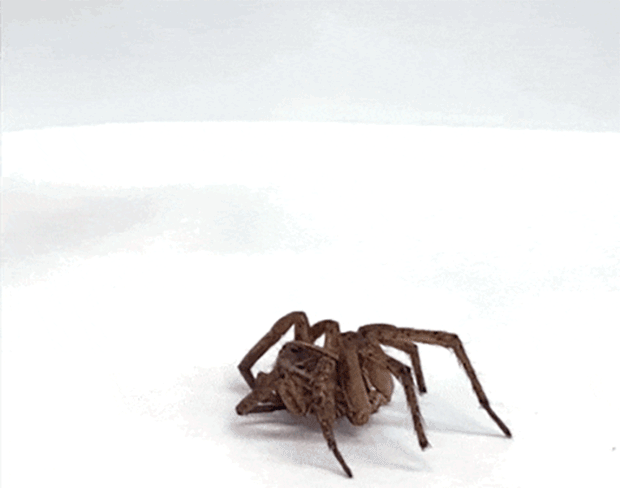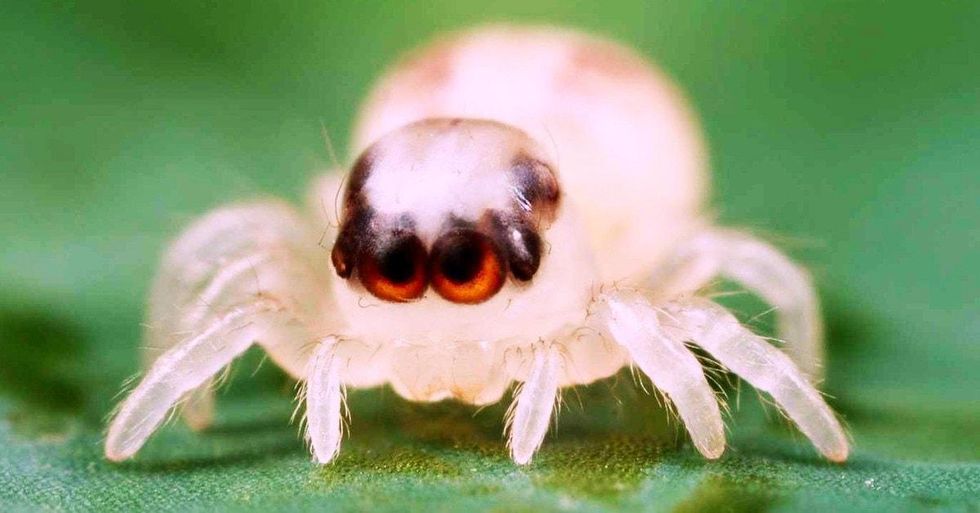Bugs have long taunted roboticists with how utterly incredible they are. Astonishingly mobile, amazingly efficient, super robust, and in some cases, literally dirt cheap. But making a robot that’s an insect equivalent is extremely hard—so hard that it’s frequently easier to just hijack living insects themselves and put them to work for us. You know what’s even easier than that, though?
Hijacking and repurposing dead bugs. Welcome to necrobotics.
Spiders are basically hydraulic (or pneumatic) grippers. Living spiders control their limbs by adjusting blood pressure on a limb-by-limb basis through an internal valve system. Higher pressure extends the limb, acting against an antagonistic flexor muscle that curls the limb when the blood pressure within is reduced. This, incidentally, is why spider legs all curl up when the spider shuffles off the mortal coil: There’s a lack of blood pressure to balance the force of the flexors.
This means that actuating all eight limbs of a spider that has joined the choir invisible is relatively straightforward. Simply stab it in the middle of that valve system, inject some air, and poof, all of the legs inflate and straighten.
Our strategy contrasts with bioinspired approaches in which researchers look to the spider’s physical morphology for design ideas that are subsequently implemented in complex engineered systems, and also differs from biohybrid systems in which live or active biological materials serve as the basis for a system, demanding careful and precise maintenance.
We repurposed the cadaver of a spider to create a pneumatically actuated gripper that is fully functional following only one simple assembly step, allowing us to circumvent the usual tedious and constraining fabrication steps required for fluidically driven actuators and grippers
This work, from researchers at the Preston Innovation Lab at Rice University, in Houston, is described in a paper just published in Advanced Science. In the paper, the team does a little bit of characterization of the performance of the deceased-spider gripper, and it’s impressive: It can lift 1.3 times its own weight, exert a peak gripping force of 0.35 millinewton, and can actuate at least 700 times before the limbs or the valve system start to degrade in any significant way. After 1,000 cycles, some cracks appear in the dead spider’s joins, likely because of dehydration. But the researchers think that by coating the spider in something like beeswax, they could likely forestall this breakdown a great deal. The demised-spider gripper is able to successfully pick up a variety of objects, likely because of a combination of the inherent compliance of the legs as well as hairlike microstructures on the legs that work kind of like a directional adhesive.
We are, unfortunately (although somewhat obviously), unable to say that no spiders were harmed over the course of this research. According to the paper, “the raw biotic material (i.e., the spider cadaver) was obtained by euthanizing a wolf spider through exposure to freezing temperature (approximately -4 °C) for a period of 5–7 days.” The researchers note that “there are currently no clear guidelines in the literature regarding ethical sourcing and humane euthanasia of spiders,” which is really something that should be figured out, considering how much we know about the cute-but-still-terrifying personalities some spiders have.
The wolf spider was a convenient choice because it exerts a gripping force approximately equal to its own weight, which raises the interesting question of what kind of performance could be expected from spiders of different sizes. Based on a scaling analysis, the researchers suggest that itty-bitty 10-milligram jumping spiders could exert a gripping force exceeding 200 percent of their body weight, while very much not itty-bitty 200-gram goliath spiders may only be able to grasp with a force that is 10 percent of their body weight. But that works out to 20 grams, which is still kind of terrifying. Goliath spiders are big.
For better or worse, insects seem likely to offer the most necrobotic potential, because fabricating pneumatics and joints and muscles at that scale can be very challenging, if not impossible. And spiders (as well as other spiderlike insects) in particular offer biodegradable, eco-friendly on-demand actuation with capabilities that the researchers hope to extend significantly. A capacitive proximity sensor could enable autonomy, for example, to “discreetly capture small biological creatures for sample collection in real-world scenarios.” Independent actuation of limbs could result in necrobotic locomotion. And the researchers are also planning to explore high-speed articulation with whip scorpions as well as true microscale manipulation with Patu digua spiders. I’ll let you google whip scorpion on your own because they kind of freak me out, but here’s a picture of a Patu digua, with a body measuring about a quarter of a millimeter:
Squee!
- Video Friday: Nanotube-Powered Insect Robots - IEEE Spectrum ›
- DARPA Wants Your Insect-Scale Robots for a Micro-Olympics - IEEE ... ›
- Micro Energy Harvesters Will Make Cyborg Insects Unstoppable ... ›
- Cyborg Fly Pilots Robot Through Obstacle Course - IEEE Spectrum ›
- Robots Grip Better When They Grip Smarter - IEEE Spectrum ›
Evan Ackerman is a senior editor at IEEE Spectrum. Since 2007, he has written over 6,000 articles on robotics and technology. He has a degree in Martian geology and is excellent at playing bagpipes.




